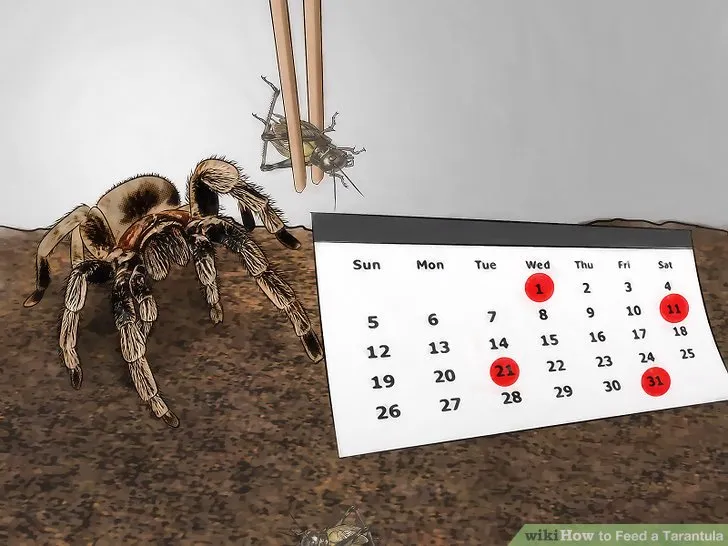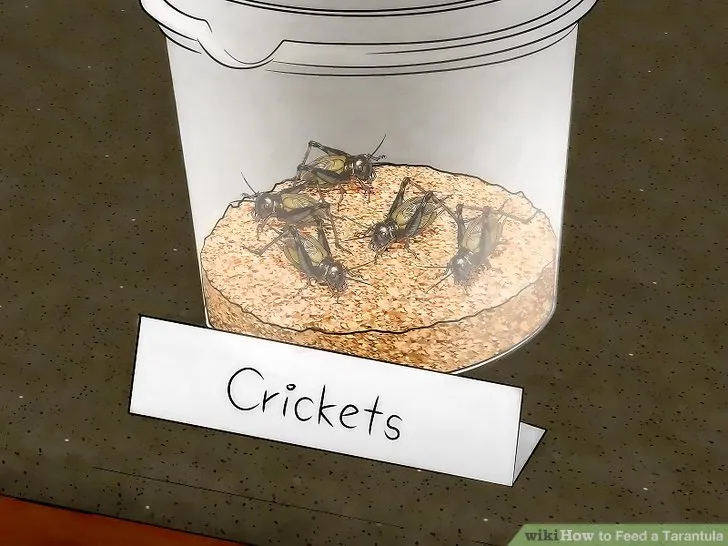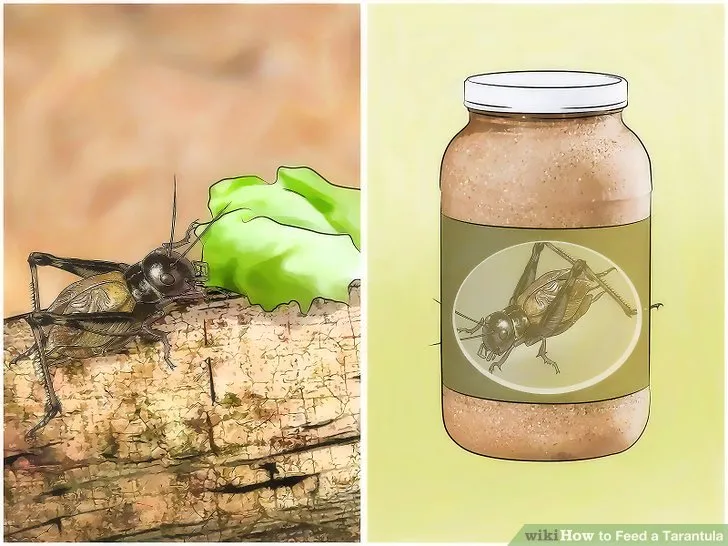Understanding Baby Tarantula Feeding Needs
Caring for a baby tarantula requires understanding their unique feeding needs. Unlike adult tarantulas, which can often go weeks or even months without eating, baby tarantulas, or slings, have a higher metabolism and require more frequent feeding. Their small size and rapid growth necessitate a consistent supply of food to ensure they develop properly. This guide provides essential information on how to feed your baby tarantula, covering everything from food selection and preparation to troubleshooting common feeding problems. Proper feeding is not just about providing food; it’s about creating a healthy environment that supports the tarantula’s growth and well-being. Failure to provide adequate nutrition can lead to stunted growth, health issues, and even premature death. Therefore, understanding and implementing these feeding guidelines is crucial for responsible tarantula ownership. Furthermore, the frequency and type of food are critical factors in your tarantula’s development.
Why Proper Feeding is Crucial
Proper feeding is the cornerstone of a healthy baby tarantula’s life. Adequate nutrition fuels their growth, supports molting, and strengthens their immune system. When a baby tarantula doesn’t receive enough food, it can suffer from several health problems, including stunted growth, weakened exoskeletons, and increased susceptibility to diseases. Molting, the process by which tarantulas shed their old exoskeleton, is particularly energy-intensive. Insufficient food can make molting difficult and potentially fatal. A well-fed tarantula will also exhibit more vibrant colors and display more active behaviors, indicating a higher level of overall health and well-being. Furthermore, consistent and appropriate feeding helps to establish a healthy feeding response, which is essential for the tarantula to thrive in captivity. Ignoring this fundamental aspect of tarantula care can lead to serious consequences, and the importance of this factor is one that cannot be overstated.
Factors Influencing Feeding Frequency

Several factors influence how often you should feed your baby tarantula. The tarantula’s size is a primary consideration; smaller slings need to be fed more frequently than larger ones. As a general rule, baby tarantulas should be fed every other day or even daily if they readily accept food. The type of tarantula species also plays a role, as some species have faster metabolisms than others. The ambient temperature of the enclosure affects the tarantula’s metabolism; warmer temperatures speed up their metabolism, requiring more frequent feeding, while cooler temperatures slow it down. Monitoring the tarantula’s abdomen size is also essential. A well-fed tarantula will have a noticeably rounded abdomen, while a skinny one may need more frequent feeding. It’s also crucial to observe their behavior. If the tarantula appears constantly hungry or actively searching for food, it may need to be fed more often. Regular monitoring and adjustments based on these factors will help you find the ideal feeding schedule for your baby tarantula. Never overfeed your tarantula, as this could cause health problems.
Choosing the Right Food for Your Baby Tarantula
Selecting the right food is crucial for the healthy development of your baby tarantula. Baby tarantulas are primarily insectivores, meaning their diet should consist mainly of insects. The most common and readily available food source is small crickets. However, other options, such as mealworms, small roaches, and fruit flies, can also be used. Variety in the diet is beneficial, but it is not always necessary. The key is to choose insects that are appropriately sized for your tarantula, ensuring they can easily catch and consume them. Additionally, the insects should be gut-loaded before feeding to your tarantula. Gut-loading involves feeding the feeder insects a nutritious diet, such as vegetables and commercial insect food, before offering them to your tarantula. This practice ensures that your tarantula receives a more balanced and nutritious meal. Always source your feeder insects from a reputable supplier to minimize the risk of introducing parasites or diseases into your tarantula’s enclosure. The overall goal is to provide nutritious and safe food for your tarantula.
Appropriate Prey Selection
Choosing the right prey is paramount for the health of your baby tarantula. Crickets, mealworms, and small roaches are commonly used as food sources. However, it is essential to consider the nutritional value and size of the prey. Crickets are generally a good choice, providing a balanced source of nutrients. Mealworms are another option, but they are higher in fat, so they should be used in moderation. Roaches are an excellent food source, providing a good balance of nutrients and are easy to care for. Always opt for live prey, as tarantulas are natural hunters and are stimulated by the hunt. Avoid wild-caught insects, as they may carry parasites or have been exposed to pesticides. Also, be sure to consider the origin of the prey to ensure it is safe for your tarantula. The ultimate objective is to supply your baby tarantula with a diet that fosters healthy growth and development.
Prey Size Guidelines

The size of the prey is a critical factor in feeding baby tarantulas. The general rule of thumb is to offer prey that is no larger than the tarantula’s body size, which excludes the legs. This ensures that the tarantula can successfully capture and consume the prey without struggling. For very small slings, it is often best to use flightless fruit flies or pinhead crickets, as they are easier to handle and digest. As the tarantula grows, you can gradually increase the size of the prey, moving up to small crickets or mealworms. Always monitor the tarantula’s feeding behavior to determine if the prey is too large; if the tarantula appears to struggle or ignores the prey, it may be too big. Avoid offering prey that is too small, as it may not provide sufficient nutrition. Remember, the goal is to provide a meal that is manageable and nutritious, promoting healthy development. Paying attention to prey size is a crucial aspect of tarantula care that directly impacts its well-being. Using the right size prey will allow your tarantula to hunt and feed without issue, thereby allowing your tarantula to flourish.
Preparing the Prey
Preparing the prey is an essential step in feeding your baby tarantula. Before offering insects to your tarantula, it’s crucial to ensure they are healthy and nutritious. The most important step is gut-loading the feeder insects. This involves feeding the insects a nutritious diet of vegetables (such as carrots, potatoes, and leafy greens) and commercial insect food for at least 24 hours before offering them to your tarantula. Gut-loading enhances the nutritional value of the prey, providing essential vitamins and minerals for your tarantula. Additionally, it is important to remove any uneaten food or debris from the feeder insect container to prevent the insects from dying or becoming unhealthy. Ensure that the feeder insects are not carrying any parasites or diseases. You can also lightly dust the insects with a calcium and vitamin D3 supplement to provide additional nutrients. By taking these steps, you will provide a much healthier meal for your baby tarantula, thereby supporting its development. This preparation helps to optimize the health benefits of the feeding process.
Feeding Baby Tarantula Step-by-Step Guide
Feeding a baby tarantula requires a straightforward process, but attention to detail is essential to ensure the tarantula’s safety and well-being. First, select the appropriate size prey, following the guidelines mentioned earlier. Then, prepare the feeding environment, making sure it is clean and free of any potential hazards. Use a pair of long tweezers to introduce the prey into the tarantula’s enclosure. Gently drop the prey near the tarantula, allowing it to hunt. Avoid disturbing the tarantula while it is eating. It is important to monitor the feeding process. Observe whether the tarantula shows interest in the prey and how it consumes it. After a reasonable time (typically a few hours), remove any uneaten prey to prevent it from stressing or potentially harming the tarantula. Regularly check the enclosure for any uneaten food. By following these steps, you can feed your baby tarantula safely and effectively, thereby fostering the development of a healthy tarantula. This structured approach ensures a stress-free feeding experience.
Setting Up the Feeding Environment

Setting up the feeding environment correctly is critical for the safety and well-being of your baby tarantula. Before introducing prey, make sure the enclosure is clean and tidy. Remove any old molts, uneaten food, or waste. This helps to maintain a healthy environment and reduces the risk of introducing pathogens. Ensure the enclosure has proper ventilation to prevent mold growth and maintain optimal humidity levels. Make sure the substrate is appropriate for the species and clean. Use a pair of long tweezers to handle the prey. This protects you from potential bites and minimizes stress for the tarantula. The setup should make it easier for the tarantula to hunt and consume the prey. Also, the environment should be free of potential hazards, such as sharp objects or loose substrate, which could harm the tarantula. A well-prepared feeding environment helps to provide a safe and stress-free feeding experience for your baby tarantula. A clean, well-maintained enclosure is essential for the overall health of your pet.
Introducing the Prey
Introducing the prey to your baby tarantula requires a careful and gentle approach. Using long tweezers, grasp the prey and bring it near the tarantula. Avoid dropping the prey directly onto the tarantula, as this can startle and stress it. Instead, gently place the prey near the tarantula’s burrow or in an area where it is likely to encounter it. Some tarantulas may immediately pounce on the prey, while others may take some time to investigate it. Be patient and allow the tarantula to respond naturally. Do not disturb the tarantula while it is eating. If the tarantula is not interested in the prey after a few hours, remove it from the enclosure. If the tarantula refuses to eat, it may not be hungry or the prey may be too large. This process is about simulating a natural feeding environment. Introduce the prey in a manner that encourages the tarantula’s hunting instincts, thereby stimulating the feeding process and promoting overall health. Introducing the prey correctly minimizes stress for the tarantula and encourages it to feed at its own pace.
Monitoring the Feeding Process
Monitoring the feeding process is crucial for ensuring your baby tarantula is eating properly and for identifying any potential problems. Observe how the tarantula interacts with the prey. Does it show immediate interest, or does it take some time to approach the prey? Watch as the tarantula captures and consumes the prey. Note how long it takes to eat and whether it struggles. If the tarantula is not interested in the prey after a few hours, remove it from the enclosure. This prevents the prey from stressing or potentially harming the tarantula. After feeding, monitor the tarantula’s abdomen to see if it is becoming more rounded, which indicates that it is well-fed. Keep a record of your feeding schedule and the tarantula’s behavior. This helps you track your tarantula’s eating habits and identify any changes that may indicate a problem. Consistent monitoring will help you tailor the feeding schedule to the specific needs of your tarantula, promoting its growth and well-being. The goal is to identify any potential health issues and allow the tarantula to flourish.
Troubleshooting Common Feeding Issues

Even with the best care, feeding problems can arise when caring for baby tarantulas. It is essential to know how to troubleshoot these issues to ensure the health and well-being of your pet. Common problems include the tarantula refusing to eat, prey escaping, and overfeeding. Knowing what to do when these issues come up helps to address any issues quickly and reduce stress on the tarantula. Understanding how to resolve common issues helps you provide the best care possible, resulting in a thriving tarantula. By understanding the underlying causes of these issues and implementing appropriate solutions, you can maintain a healthy feeding routine for your baby tarantula.
Tarantula Refusal to Eat
Sometimes, baby tarantulas may refuse to eat. Several factors can cause this, including stress, molting, and environmental issues. Stress can be caused by environmental factors, such as excessive handling or a lack of proper hide. Tarantulas often stop eating before molting. If your tarantula has a darkened abdomen or appears lethargic, it may be preparing to molt. Make sure the enclosure has proper temperature and humidity levels. Check the humidity and ensure it’s appropriate for the species. If the tarantula is stressed, provide a secure hide and minimize handling. If the tarantula is preparing to molt, do not offer food. If the problem persists, consult with an experienced tarantula keeper or veterinarian. By understanding the potential causes and taking appropriate action, you can help your tarantula resume eating and ensure its well-being. Patience is key; often, the tarantula will start eating again on its own once the underlying issue is resolved. Ignoring this behavior could result in the tarantula losing weight and lead to other health issues.
Prey Escaping
Prey escaping within the enclosure is a common problem. This can be caused by various factors, including the prey being too fast, the enclosure not being secure, or the tarantula not being interested in the prey. To prevent escape, ensure the enclosure has a secure lid. Make sure there are no gaps or holes where the prey can get out. Using tweezers when introducing prey can minimize the chances of it escaping. Monitor the feeding process and remove any uneaten prey to prevent escapes. If the prey frequently escapes, try a different type of prey or reduce the size of the prey. Keeping the prey contained is essential to prevent the tarantula from becoming stressed and to maintain a clean enclosure. If prey does escape, carefully remove it from the enclosure. Preventing prey from escaping is essential for maintaining a healthy enclosure environment. Always monitor the feeding and try to implement the changes necessary to prevent any prey from escaping.
Overfeeding Concerns

Overfeeding is another issue that can affect baby tarantulas. While it may seem counterintuitive, overfeeding can be just as harmful as underfeeding. Overfeeding can lead to excessive weight gain, which can put stress on the tarantula’s exoskeleton and make molting more difficult. It can also result in a buildup of waste and uneaten food in the enclosure, increasing the risk of bacterial or fungal infections. To avoid overfeeding, monitor the tarantula’s abdomen. If it appears overly rounded, reduce the frequency of feeding. Feed the tarantula only what it can consume in a reasonable amount of time, and always remove any uneaten prey. Adjust the feeding schedule according to the tarantula’s size, growth rate, and appetite. By avoiding overfeeding and implementing the proper feeding techniques, you can ensure the long-term health and well-being of your baby tarantula. Excessive weight can lead to health problems, so knowing how much to feed your tarantula is crucial for its development.
Maintaining a Healthy Baby Tarantula
Maintaining a healthy baby tarantula involves more than just proper feeding. It also includes providing fresh water, ensuring optimal humidity, and regularly cleaning the enclosure. Consistent attention to these factors promotes the well-being of the tarantula. By combining proper feeding with these aspects of care, you create a thriving environment where your tarantula can thrive. These actions are essential for creating a healthy and safe environment for your pet, and it is the responsibility of all tarantula owners to follow these guidelines for the health of their pets. Maintaining the overall health of your tarantula can be achieved by focusing on these aspects of care. All of the steps discussed will help ensure your tarantula’s well-being and contribute to a long, healthy life.
Providing Fresh Water
Providing fresh water is a crucial aspect of baby tarantula care. Always provide a shallow water dish with clean, fresh water. Baby tarantulas are small, so a bottle cap or a shallow dish is often sufficient. Change the water regularly, typically every few days, to prevent bacterial growth. Some tarantula keepers prefer to use a small piece of cotton or a sponge in the water dish to prevent the tarantula from drowning, although this is not always necessary. Monitor the water dish and ensure it is clean. Avoid using tap water that contains chlorine, as it can be harmful to tarantulas. If necessary, use dechlorinated water or bottled water. Having fresh, clean water is essential for hydration, supporting essential bodily functions, and overall health and well-being. The regular provision of clean water ensures the tarantula stays healthy.
Ensuring Optimal Humidity

Ensuring optimal humidity levels is critical for the health of your baby tarantula, particularly during molting. The appropriate humidity levels vary depending on the tarantula species. Generally, humidity levels should be between 60% and 80%. You can measure the humidity using a hygrometer. To maintain the correct humidity level, mist the enclosure lightly with water as needed. Avoid over-misting, as this can lead to mold growth and other issues. Providing a water dish also helps to maintain humidity. The substrate can also help regulate humidity. Ensure the substrate is damp but not waterlogged. Adjust the ventilation in the enclosure as needed to control humidity. Improper humidity levels can make molting difficult. Therefore, this is a crucial step in caring for a baby tarantula. Always research the specific needs of your tarantula species, and adjust your care accordingly. The proper humidity levels support the tarantula’s health and facilitate proper molting.
Regular Enclosure Cleaning
Regular cleaning of the enclosure is an essential part of maintaining a healthy environment for your baby tarantula. Spot-clean the enclosure regularly, removing any uneaten food, molts, or waste. This helps to prevent the growth of bacteria, mold, and other pathogens. Replace the substrate periodically, typically every few months, depending on the size of the enclosure and the amount of waste. When cleaning the enclosure, make sure the tarantula is safely housed in a separate container. Use a mild soap and water solution to clean the enclosure. Be sure to rinse the enclosure thoroughly to remove any soap residue. A clean enclosure is essential for the overall health and well-being of your baby tarantula. Regularly cleaning the enclosure and providing an appropriate living environment helps create a healthy and safe habitat for your tarantula to thrive. Performing regular cleaning is a good way to prevent the spread of bacteria.
